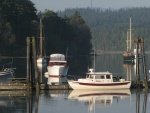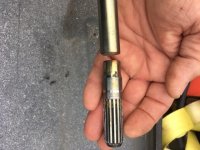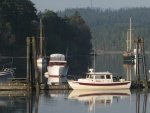I'm a new skipper (2 years), but have been boating as crew for decades. Last week, I had a slow, soft sandbar grounding on my 22. I can blame the channel marker that was missing all its red paint, or I can admit not carefully watching my Garmin or the color of the water in a minus tide. In a known hazard area. Duh. My daughter pushed us off in seconds.
So I subsequently discovered my twin Honda 40s both have issues, but different on starboard and port. Port prop was probably spun and has already been replaced this week. The other new prop for starboard will be here in a couple days and I really hope the starboard engine will be fine after replacing the prop.
Here are the symptoms: both engines start and run fine, got thoroughly rinsed with freshwater after grounding. Starboard revs but only delivers about half the normal thrust and tops out on speed at only about 5 knots. I'm pretty sure that's just a spun prop; will replace it and test this week.
It's my port engine I'm worried about. I did replace that prop already and the problem persists; it starts and revs just fine but the new prop does not spin at all in drive. I did just have spring maintenance done and had a tech swap out my Garmin and transducer. Is there any way the cabling could have come loose coincidentally? Am I looking at a damaged lower unit? What could a slow soft grounding in sand have done to the workings of the lower unit? Maybe my dog gear was about to go anyway. I do know that during maintenance they didn't change the port impeller because the shop said the bolts were seized; so, I have to deal with those bolts anyway. How can I eliminate any other factors before I take apart the lower unit or pay boucoups bucks to have a shop do it? Is there a method to test the shift cabling while on the trailer?
Doctors of Outboards, what's your diagnosis for this port engine not having any thrust?
So I subsequently discovered my twin Honda 40s both have issues, but different on starboard and port. Port prop was probably spun and has already been replaced this week. The other new prop for starboard will be here in a couple days and I really hope the starboard engine will be fine after replacing the prop.
Here are the symptoms: both engines start and run fine, got thoroughly rinsed with freshwater after grounding. Starboard revs but only delivers about half the normal thrust and tops out on speed at only about 5 knots. I'm pretty sure that's just a spun prop; will replace it and test this week.
It's my port engine I'm worried about. I did replace that prop already and the problem persists; it starts and revs just fine but the new prop does not spin at all in drive. I did just have spring maintenance done and had a tech swap out my Garmin and transducer. Is there any way the cabling could have come loose coincidentally? Am I looking at a damaged lower unit? What could a slow soft grounding in sand have done to the workings of the lower unit? Maybe my dog gear was about to go anyway. I do know that during maintenance they didn't change the port impeller because the shop said the bolts were seized; so, I have to deal with those bolts anyway. How can I eliminate any other factors before I take apart the lower unit or pay boucoups bucks to have a shop do it? Is there a method to test the shift cabling while on the trailer?
Doctors of Outboards, what's your diagnosis for this port engine not having any thrust?



